Importance of Perinatal and Postnatal Care for Mothers and Babies
VerifiedAdded on 2022/11/22
|13
|4080
|105
AI Summary
This article discusses the importance of perinatal and postnatal care for mothers and babies. It covers risk factors that impact perinatal health, management of prematurity in NICU, and holistic postnatal care and management. The article also includes a case study of a complex pregnancy followed by a preterm birth.
Contribute Materials
Your contribution can guide someone’s learning journey. Share your
documents today.
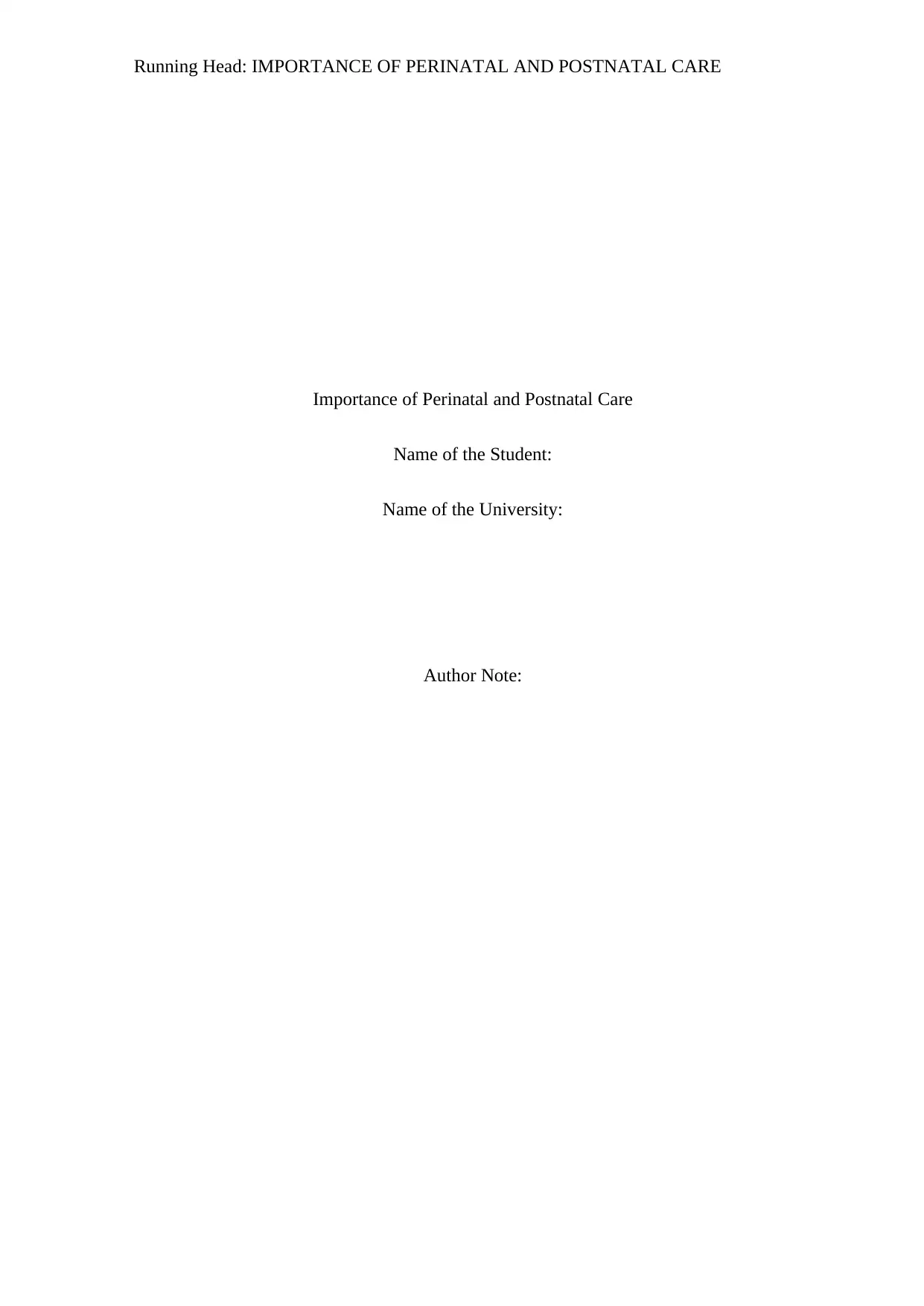
Running Head: IMPORTANCE OF PERINATAL AND POSTNATAL CARE
Importance of Perinatal and Postnatal Care
Name of the Student:
Name of the University:
Author Note:
Importance of Perinatal and Postnatal Care
Name of the Student:
Name of the University:
Author Note:
Secure Best Marks with AI Grader
Need help grading? Try our AI Grader for instant feedback on your assignments.
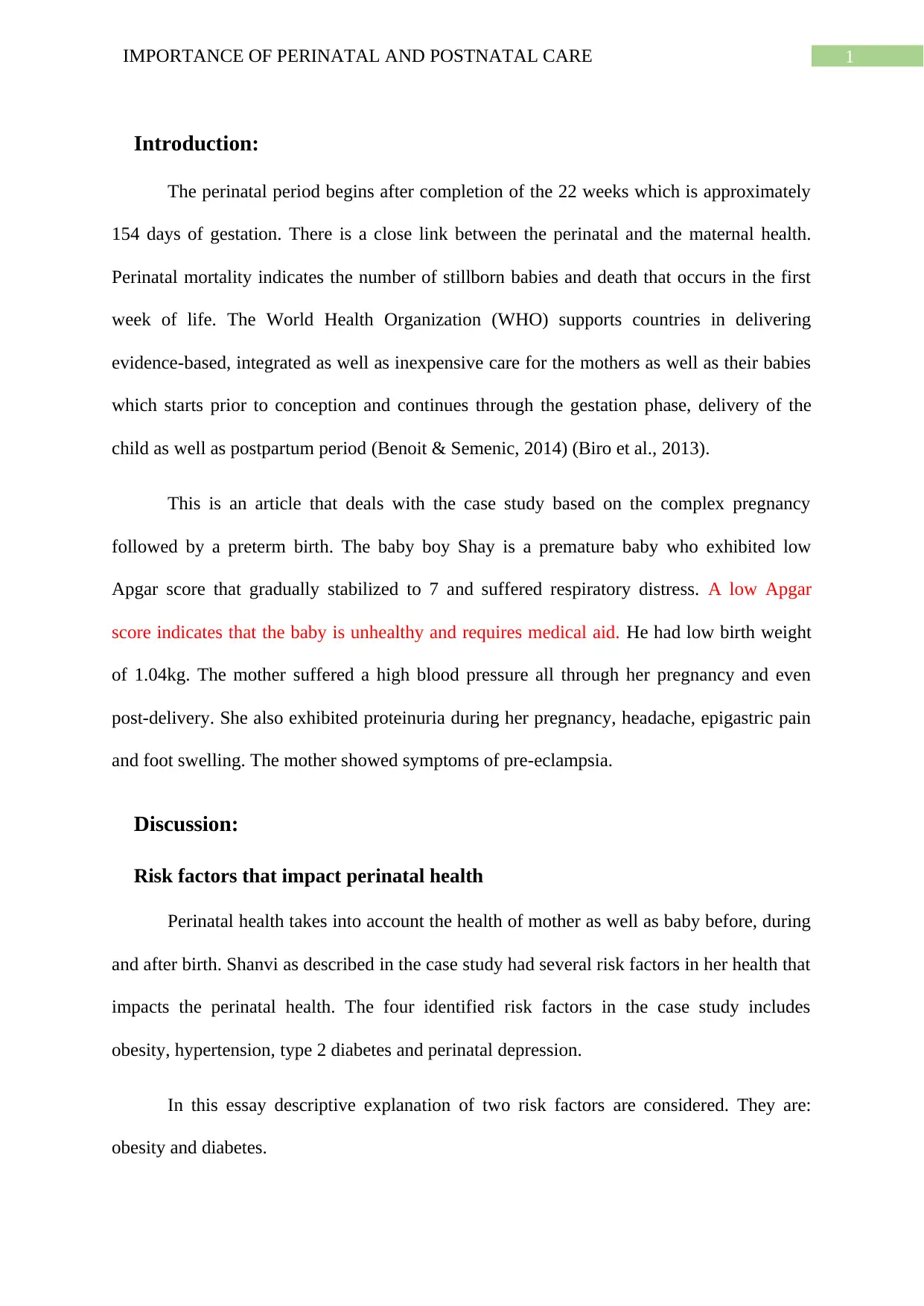
1IMPORTANCE OF PERINATAL AND POSTNATAL CARE
Introduction:
The perinatal period begins after completion of the 22 weeks which is approximately
154 days of gestation. There is a close link between the perinatal and the maternal health.
Perinatal mortality indicates the number of stillborn babies and death that occurs in the first
week of life. The World Health Organization (WHO) supports countries in delivering
evidence-based, integrated as well as inexpensive care for the mothers as well as their babies
which starts prior to conception and continues through the gestation phase, delivery of the
child as well as postpartum period (Benoit & Semenic, 2014) (Biro et al., 2013).
This is an article that deals with the case study based on the complex pregnancy
followed by a preterm birth. The baby boy Shay is a premature baby who exhibited low
Apgar score that gradually stabilized to 7 and suffered respiratory distress. A low Apgar
score indicates that the baby is unhealthy and requires medical aid. He had low birth weight
of 1.04kg. The mother suffered a high blood pressure all through her pregnancy and even
post-delivery. She also exhibited proteinuria during her pregnancy, headache, epigastric pain
and foot swelling. The mother showed symptoms of pre-eclampsia.
Discussion:
Risk factors that impact perinatal health
Perinatal health takes into account the health of mother as well as baby before, during
and after birth. Shanvi as described in the case study had several risk factors in her health that
impacts the perinatal health. The four identified risk factors in the case study includes
obesity, hypertension, type 2 diabetes and perinatal depression.
In this essay descriptive explanation of two risk factors are considered. They are:
obesity and diabetes.
Introduction:
The perinatal period begins after completion of the 22 weeks which is approximately
154 days of gestation. There is a close link between the perinatal and the maternal health.
Perinatal mortality indicates the number of stillborn babies and death that occurs in the first
week of life. The World Health Organization (WHO) supports countries in delivering
evidence-based, integrated as well as inexpensive care for the mothers as well as their babies
which starts prior to conception and continues through the gestation phase, delivery of the
child as well as postpartum period (Benoit & Semenic, 2014) (Biro et al., 2013).
This is an article that deals with the case study based on the complex pregnancy
followed by a preterm birth. The baby boy Shay is a premature baby who exhibited low
Apgar score that gradually stabilized to 7 and suffered respiratory distress. A low Apgar
score indicates that the baby is unhealthy and requires medical aid. He had low birth weight
of 1.04kg. The mother suffered a high blood pressure all through her pregnancy and even
post-delivery. She also exhibited proteinuria during her pregnancy, headache, epigastric pain
and foot swelling. The mother showed symptoms of pre-eclampsia.
Discussion:
Risk factors that impact perinatal health
Perinatal health takes into account the health of mother as well as baby before, during
and after birth. Shanvi as described in the case study had several risk factors in her health that
impacts the perinatal health. The four identified risk factors in the case study includes
obesity, hypertension, type 2 diabetes and perinatal depression.
In this essay descriptive explanation of two risk factors are considered. They are:
obesity and diabetes.
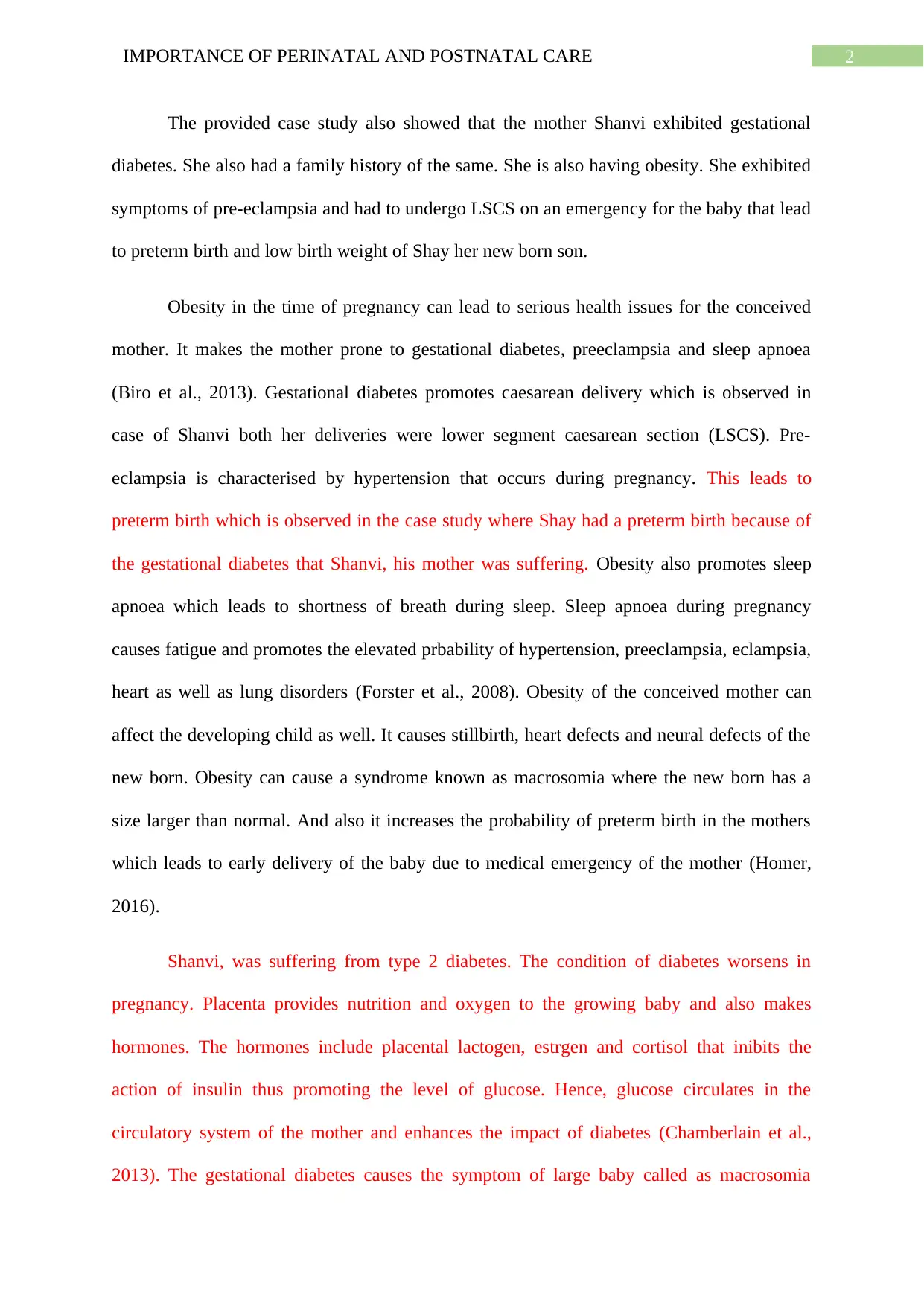
2IMPORTANCE OF PERINATAL AND POSTNATAL CARE
The provided case study also showed that the mother Shanvi exhibited gestational
diabetes. She also had a family history of the same. She is also having obesity. She exhibited
symptoms of pre-eclampsia and had to undergo LSCS on an emergency for the baby that lead
to preterm birth and low birth weight of Shay her new born son.
Obesity in the time of pregnancy can lead to serious health issues for the conceived
mother. It makes the mother prone to gestational diabetes, preeclampsia and sleep apnoea
(Biro et al., 2013). Gestational diabetes promotes caesarean delivery which is observed in
case of Shanvi both her deliveries were lower segment caesarean section (LSCS). Pre-
eclampsia is characterised by hypertension that occurs during pregnancy. This leads to
preterm birth which is observed in the case study where Shay had a preterm birth because of
the gestational diabetes that Shanvi, his mother was suffering. Obesity also promotes sleep
apnoea which leads to shortness of breath during sleep. Sleep apnoea during pregnancy
causes fatigue and promotes the elevated prbability of hypertension, preeclampsia, eclampsia,
heart as well as lung disorders (Forster et al., 2008). Obesity of the conceived mother can
affect the developing child as well. It causes stillbirth, heart defects and neural defects of the
new born. Obesity can cause a syndrome known as macrosomia where the new born has a
size larger than normal. And also it increases the probability of preterm birth in the mothers
which leads to early delivery of the baby due to medical emergency of the mother (Homer,
2016).
Shanvi, was suffering from type 2 diabetes. The condition of diabetes worsens in
pregnancy. Placenta provides nutrition and oxygen to the growing baby and also makes
hormones. The hormones include placental lactogen, estrgen and cortisol that inibits the
action of insulin thus promoting the level of glucose. Hence, glucose circulates in the
circulatory system of the mother and enhances the impact of diabetes (Chamberlain et al.,
2013). The gestational diabetes causes the symptom of large baby called as macrosomia
The provided case study also showed that the mother Shanvi exhibited gestational
diabetes. She also had a family history of the same. She is also having obesity. She exhibited
symptoms of pre-eclampsia and had to undergo LSCS on an emergency for the baby that lead
to preterm birth and low birth weight of Shay her new born son.
Obesity in the time of pregnancy can lead to serious health issues for the conceived
mother. It makes the mother prone to gestational diabetes, preeclampsia and sleep apnoea
(Biro et al., 2013). Gestational diabetes promotes caesarean delivery which is observed in
case of Shanvi both her deliveries were lower segment caesarean section (LSCS). Pre-
eclampsia is characterised by hypertension that occurs during pregnancy. This leads to
preterm birth which is observed in the case study where Shay had a preterm birth because of
the gestational diabetes that Shanvi, his mother was suffering. Obesity also promotes sleep
apnoea which leads to shortness of breath during sleep. Sleep apnoea during pregnancy
causes fatigue and promotes the elevated prbability of hypertension, preeclampsia, eclampsia,
heart as well as lung disorders (Forster et al., 2008). Obesity of the conceived mother can
affect the developing child as well. It causes stillbirth, heart defects and neural defects of the
new born. Obesity can cause a syndrome known as macrosomia where the new born has a
size larger than normal. And also it increases the probability of preterm birth in the mothers
which leads to early delivery of the baby due to medical emergency of the mother (Homer,
2016).
Shanvi, was suffering from type 2 diabetes. The condition of diabetes worsens in
pregnancy. Placenta provides nutrition and oxygen to the growing baby and also makes
hormones. The hormones include placental lactogen, estrgen and cortisol that inibits the
action of insulin thus promoting the level of glucose. Hence, glucose circulates in the
circulatory system of the mother and enhances the impact of diabetes (Chamberlain et al.,
2013). The gestational diabetes causes the symptom of large baby called as macrosomia
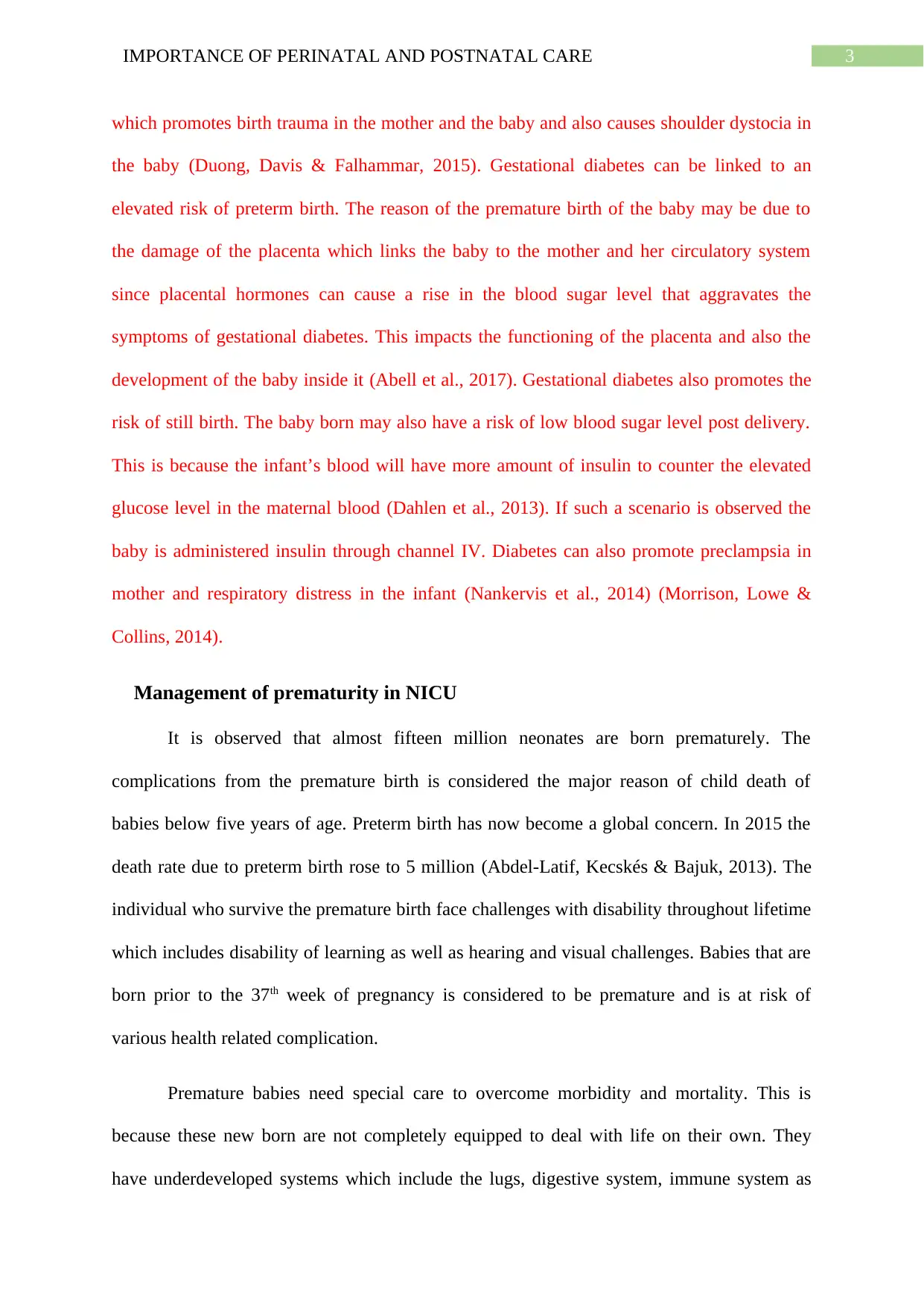
3IMPORTANCE OF PERINATAL AND POSTNATAL CARE
which promotes birth trauma in the mother and the baby and also causes shoulder dystocia in
the baby (Duong, Davis & Falhammar, 2015). Gestational diabetes can be linked to an
elevated risk of preterm birth. The reason of the premature birth of the baby may be due to
the damage of the placenta which links the baby to the mother and her circulatory system
since placental hormones can cause a rise in the blood sugar level that aggravates the
symptoms of gestational diabetes. This impacts the functioning of the placenta and also the
development of the baby inside it (Abell et al., 2017). Gestational diabetes also promotes the
risk of still birth. The baby born may also have a risk of low blood sugar level post delivery.
This is because the infant’s blood will have more amount of insulin to counter the elevated
glucose level in the maternal blood (Dahlen et al., 2013). If such a scenario is observed the
baby is administered insulin through channel IV. Diabetes can also promote preclampsia in
mother and respiratory distress in the infant (Nankervis et al., 2014) (Morrison, Lowe &
Collins, 2014).
Management of prematurity in NICU
It is observed that almost fifteen million neonates are born prematurely. The
complications from the premature birth is considered the major reason of child death of
babies below five years of age. Preterm birth has now become a global concern. In 2015 the
death rate due to preterm birth rose to 5 million (Abdel-Latif, Kecskés & Bajuk, 2013). The
individual who survive the premature birth face challenges with disability throughout lifetime
which includes disability of learning as well as hearing and visual challenges. Babies that are
born prior to the 37th week of pregnancy is considered to be premature and is at risk of
various health related complication.
Premature babies need special care to overcome morbidity and mortality. This is
because these new born are not completely equipped to deal with life on their own. They
have underdeveloped systems which include the lugs, digestive system, immune system as
which promotes birth trauma in the mother and the baby and also causes shoulder dystocia in
the baby (Duong, Davis & Falhammar, 2015). Gestational diabetes can be linked to an
elevated risk of preterm birth. The reason of the premature birth of the baby may be due to
the damage of the placenta which links the baby to the mother and her circulatory system
since placental hormones can cause a rise in the blood sugar level that aggravates the
symptoms of gestational diabetes. This impacts the functioning of the placenta and also the
development of the baby inside it (Abell et al., 2017). Gestational diabetes also promotes the
risk of still birth. The baby born may also have a risk of low blood sugar level post delivery.
This is because the infant’s blood will have more amount of insulin to counter the elevated
glucose level in the maternal blood (Dahlen et al., 2013). If such a scenario is observed the
baby is administered insulin through channel IV. Diabetes can also promote preclampsia in
mother and respiratory distress in the infant (Nankervis et al., 2014) (Morrison, Lowe &
Collins, 2014).
Management of prematurity in NICU
It is observed that almost fifteen million neonates are born prematurely. The
complications from the premature birth is considered the major reason of child death of
babies below five years of age. Preterm birth has now become a global concern. In 2015 the
death rate due to preterm birth rose to 5 million (Abdel-Latif, Kecskés & Bajuk, 2013). The
individual who survive the premature birth face challenges with disability throughout lifetime
which includes disability of learning as well as hearing and visual challenges. Babies that are
born prior to the 37th week of pregnancy is considered to be premature and is at risk of
various health related complication.
Premature babies need special care to overcome morbidity and mortality. This is
because these new born are not completely equipped to deal with life on their own. They
have underdeveloped systems which include the lugs, digestive system, immune system as
Secure Best Marks with AI Grader
Need help grading? Try our AI Grader for instant feedback on your assignments.
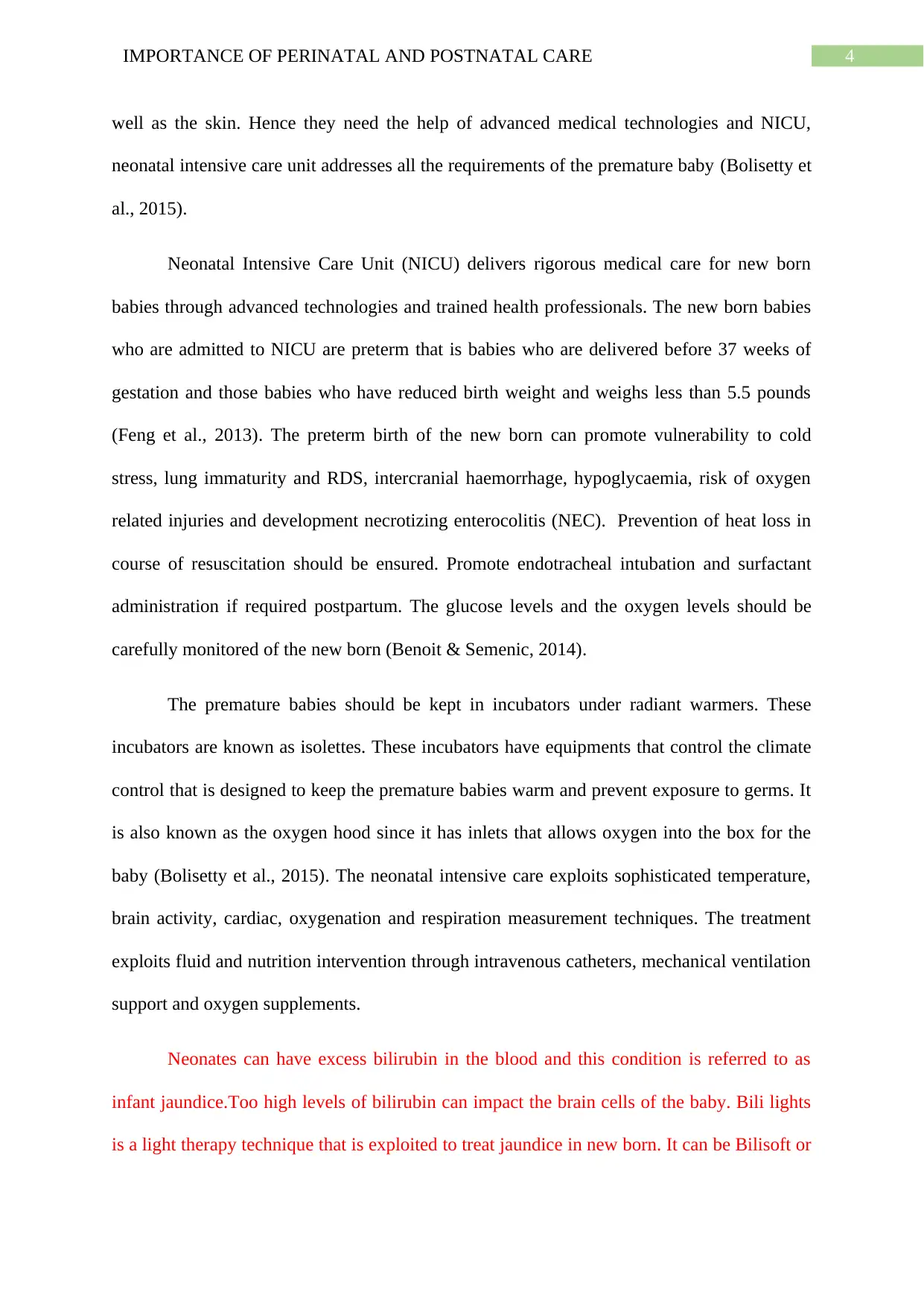
4IMPORTANCE OF PERINATAL AND POSTNATAL CARE
well as the skin. Hence they need the help of advanced medical technologies and NICU,
neonatal intensive care unit addresses all the requirements of the premature baby (Bolisetty et
al., 2015).
Neonatal Intensive Care Unit (NICU) delivers rigorous medical care for new born
babies through advanced technologies and trained health professionals. The new born babies
who are admitted to NICU are preterm that is babies who are delivered before 37 weeks of
gestation and those babies who have reduced birth weight and weighs less than 5.5 pounds
(Feng et al., 2013). The preterm birth of the new born can promote vulnerability to cold
stress, lung immaturity and RDS, intercranial haemorrhage, hypoglycaemia, risk of oxygen
related injuries and development necrotizing enterocolitis (NEC). Prevention of heat loss in
course of resuscitation should be ensured. Promote endotracheal intubation and surfactant
administration if required postpartum. The glucose levels and the oxygen levels should be
carefully monitored of the new born (Benoit & Semenic, 2014).
The premature babies should be kept in incubators under radiant warmers. These
incubators are known as isolettes. These incubators have equipments that control the climate
control that is designed to keep the premature babies warm and prevent exposure to germs. It
is also known as the oxygen hood since it has inlets that allows oxygen into the box for the
baby (Bolisetty et al., 2015). The neonatal intensive care exploits sophisticated temperature,
brain activity, cardiac, oxygenation and respiration measurement techniques. The treatment
exploits fluid and nutrition intervention through intravenous catheters, mechanical ventilation
support and oxygen supplements.
Neonates can have excess bilirubin in the blood and this condition is referred to as
infant jaundice.Too high levels of bilirubin can impact the brain cells of the baby. Bili lights
is a light therapy technique that is exploited to treat jaundice in new born. It can be Bilisoft or
well as the skin. Hence they need the help of advanced medical technologies and NICU,
neonatal intensive care unit addresses all the requirements of the premature baby (Bolisetty et
al., 2015).
Neonatal Intensive Care Unit (NICU) delivers rigorous medical care for new born
babies through advanced technologies and trained health professionals. The new born babies
who are admitted to NICU are preterm that is babies who are delivered before 37 weeks of
gestation and those babies who have reduced birth weight and weighs less than 5.5 pounds
(Feng et al., 2013). The preterm birth of the new born can promote vulnerability to cold
stress, lung immaturity and RDS, intercranial haemorrhage, hypoglycaemia, risk of oxygen
related injuries and development necrotizing enterocolitis (NEC). Prevention of heat loss in
course of resuscitation should be ensured. Promote endotracheal intubation and surfactant
administration if required postpartum. The glucose levels and the oxygen levels should be
carefully monitored of the new born (Benoit & Semenic, 2014).
The premature babies should be kept in incubators under radiant warmers. These
incubators are known as isolettes. These incubators have equipments that control the climate
control that is designed to keep the premature babies warm and prevent exposure to germs. It
is also known as the oxygen hood since it has inlets that allows oxygen into the box for the
baby (Bolisetty et al., 2015). The neonatal intensive care exploits sophisticated temperature,
brain activity, cardiac, oxygenation and respiration measurement techniques. The treatment
exploits fluid and nutrition intervention through intravenous catheters, mechanical ventilation
support and oxygen supplements.
Neonates can have excess bilirubin in the blood and this condition is referred to as
infant jaundice.Too high levels of bilirubin can impact the brain cells of the baby. Bili lights
is a light therapy technique that is exploited to treat jaundice in new born. It can be Bilisoft or
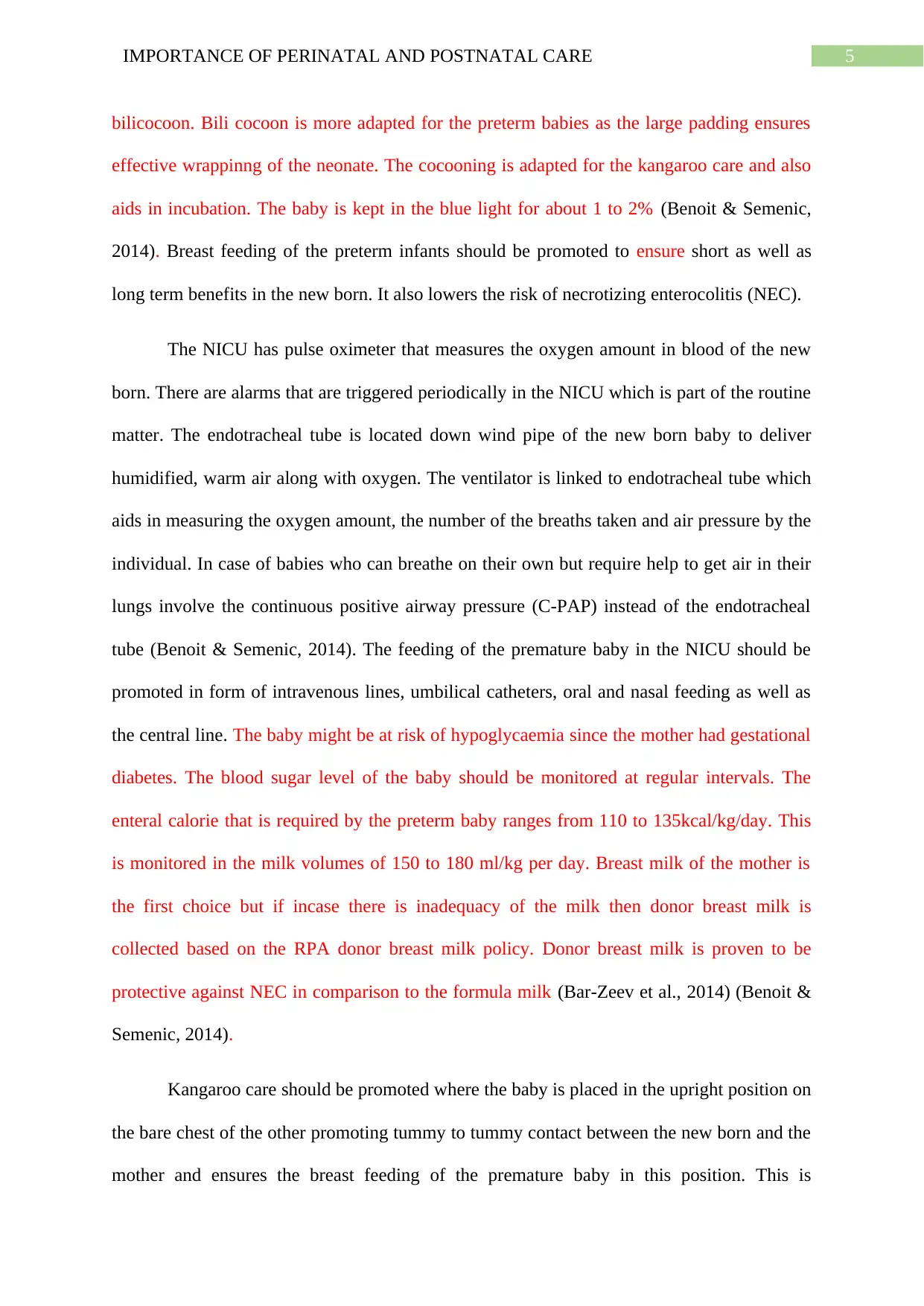
5IMPORTANCE OF PERINATAL AND POSTNATAL CARE
bilicocoon. Bili cocoon is more adapted for the preterm babies as the large padding ensures
effective wrappinng of the neonate. The cocooning is adapted for the kangaroo care and also
aids in incubation. The baby is kept in the blue light for about 1 to 2% (Benoit & Semenic,
2014). Breast feeding of the preterm infants should be promoted to ensure short as well as
long term benefits in the new born. It also lowers the risk of necrotizing enterocolitis (NEC).
The NICU has pulse oximeter that measures the oxygen amount in blood of the new
born. There are alarms that are triggered periodically in the NICU which is part of the routine
matter. The endotracheal tube is located down wind pipe of the new born baby to deliver
humidified, warm air along with oxygen. The ventilator is linked to endotracheal tube which
aids in measuring the oxygen amount, the number of the breaths taken and air pressure by the
individual. In case of babies who can breathe on their own but require help to get air in their
lungs involve the continuous positive airway pressure (C-PAP) instead of the endotracheal
tube (Benoit & Semenic, 2014). The feeding of the premature baby in the NICU should be
promoted in form of intravenous lines, umbilical catheters, oral and nasal feeding as well as
the central line. The baby might be at risk of hypoglycaemia since the mother had gestational
diabetes. The blood sugar level of the baby should be monitored at regular intervals. The
enteral calorie that is required by the preterm baby ranges from 110 to 135kcal/kg/day. This
is monitored in the milk volumes of 150 to 180 ml/kg per day. Breast milk of the mother is
the first choice but if incase there is inadequacy of the milk then donor breast milk is
collected based on the RPA donor breast milk policy. Donor breast milk is proven to be
protective against NEC in comparison to the formula milk (Bar-Zeev et al., 2014) (Benoit &
Semenic, 2014).
Kangaroo care should be promoted where the baby is placed in the upright position on
the bare chest of the other promoting tummy to tummy contact between the new born and the
mother and ensures the breast feeding of the premature baby in this position. This is
bilicocoon. Bili cocoon is more adapted for the preterm babies as the large padding ensures
effective wrappinng of the neonate. The cocooning is adapted for the kangaroo care and also
aids in incubation. The baby is kept in the blue light for about 1 to 2% (Benoit & Semenic,
2014). Breast feeding of the preterm infants should be promoted to ensure short as well as
long term benefits in the new born. It also lowers the risk of necrotizing enterocolitis (NEC).
The NICU has pulse oximeter that measures the oxygen amount in blood of the new
born. There are alarms that are triggered periodically in the NICU which is part of the routine
matter. The endotracheal tube is located down wind pipe of the new born baby to deliver
humidified, warm air along with oxygen. The ventilator is linked to endotracheal tube which
aids in measuring the oxygen amount, the number of the breaths taken and air pressure by the
individual. In case of babies who can breathe on their own but require help to get air in their
lungs involve the continuous positive airway pressure (C-PAP) instead of the endotracheal
tube (Benoit & Semenic, 2014). The feeding of the premature baby in the NICU should be
promoted in form of intravenous lines, umbilical catheters, oral and nasal feeding as well as
the central line. The baby might be at risk of hypoglycaemia since the mother had gestational
diabetes. The blood sugar level of the baby should be monitored at regular intervals. The
enteral calorie that is required by the preterm baby ranges from 110 to 135kcal/kg/day. This
is monitored in the milk volumes of 150 to 180 ml/kg per day. Breast milk of the mother is
the first choice but if incase there is inadequacy of the milk then donor breast milk is
collected based on the RPA donor breast milk policy. Donor breast milk is proven to be
protective against NEC in comparison to the formula milk (Bar-Zeev et al., 2014) (Benoit &
Semenic, 2014).
Kangaroo care should be promoted where the baby is placed in the upright position on
the bare chest of the other promoting tummy to tummy contact between the new born and the
mother and ensures the breast feeding of the premature baby in this position. This is
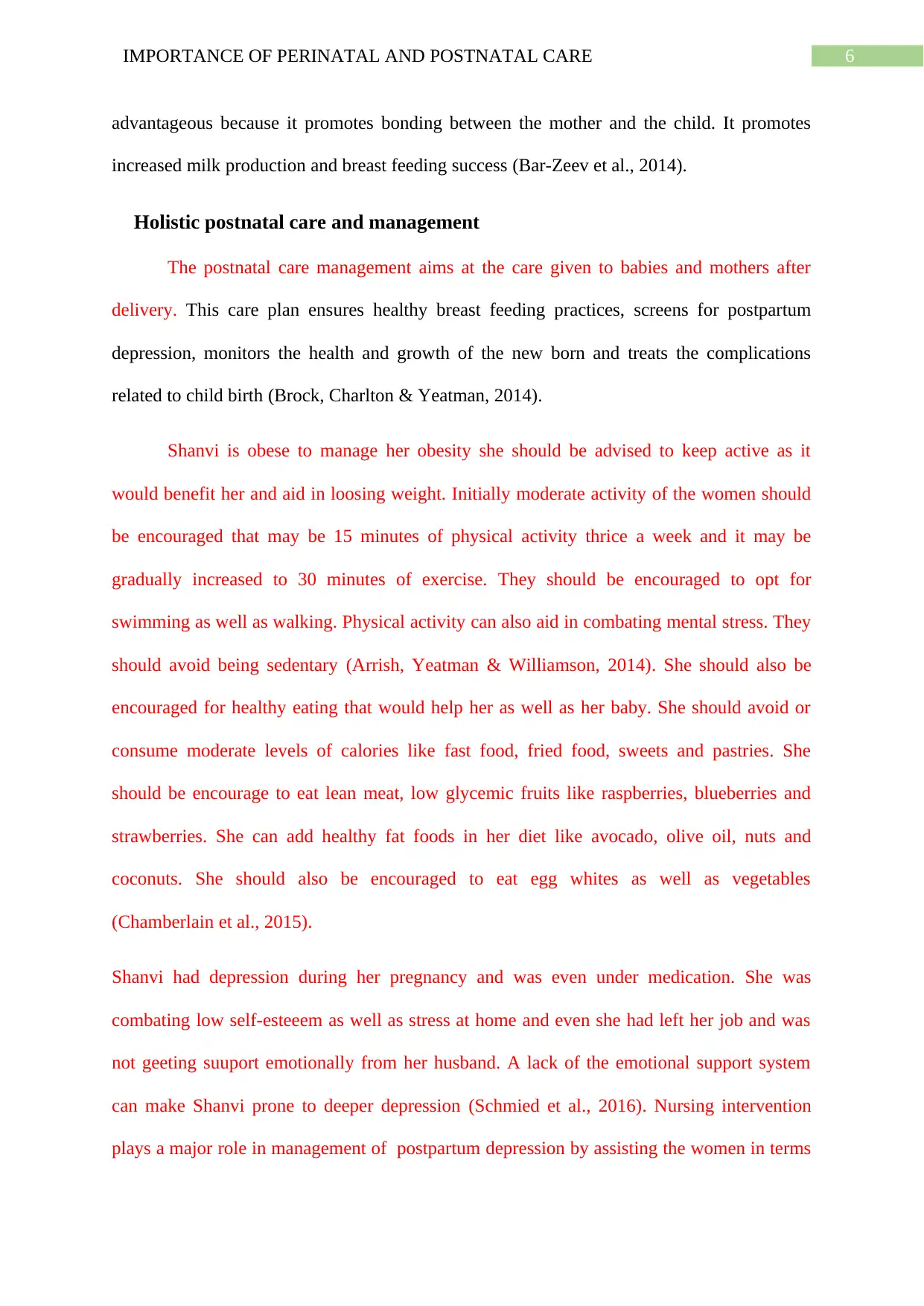
6IMPORTANCE OF PERINATAL AND POSTNATAL CARE
advantageous because it promotes bonding between the mother and the child. It promotes
increased milk production and breast feeding success (Bar-Zeev et al., 2014).
Holistic postnatal care and management
The postnatal care management aims at the care given to babies and mothers after
delivery. This care plan ensures healthy breast feeding practices, screens for postpartum
depression, monitors the health and growth of the new born and treats the complications
related to child birth (Brock, Charlton & Yeatman, 2014).
Shanvi is obese to manage her obesity she should be advised to keep active as it
would benefit her and aid in loosing weight. Initially moderate activity of the women should
be encouraged that may be 15 minutes of physical activity thrice a week and it may be
gradually increased to 30 minutes of exercise. They should be encouraged to opt for
swimming as well as walking. Physical activity can also aid in combating mental stress. They
should avoid being sedentary (Arrish, Yeatman & Williamson, 2014). She should also be
encouraged for healthy eating that would help her as well as her baby. She should avoid or
consume moderate levels of calories like fast food, fried food, sweets and pastries. She
should be encourage to eat lean meat, low glycemic fruits like raspberries, blueberries and
strawberries. She can add healthy fat foods in her diet like avocado, olive oil, nuts and
coconuts. She should also be encouraged to eat egg whites as well as vegetables
(Chamberlain et al., 2015).
Shanvi had depression during her pregnancy and was even under medication. She was
combating low self-esteeem as well as stress at home and even she had left her job and was
not geeting suuport emotionally from her husband. A lack of the emotional support system
can make Shanvi prone to deeper depression (Schmied et al., 2016). Nursing intervention
plays a major role in management of postpartum depression by assisting the women in terms
advantageous because it promotes bonding between the mother and the child. It promotes
increased milk production and breast feeding success (Bar-Zeev et al., 2014).
Holistic postnatal care and management
The postnatal care management aims at the care given to babies and mothers after
delivery. This care plan ensures healthy breast feeding practices, screens for postpartum
depression, monitors the health and growth of the new born and treats the complications
related to child birth (Brock, Charlton & Yeatman, 2014).
Shanvi is obese to manage her obesity she should be advised to keep active as it
would benefit her and aid in loosing weight. Initially moderate activity of the women should
be encouraged that may be 15 minutes of physical activity thrice a week and it may be
gradually increased to 30 minutes of exercise. They should be encouraged to opt for
swimming as well as walking. Physical activity can also aid in combating mental stress. They
should avoid being sedentary (Arrish, Yeatman & Williamson, 2014). She should also be
encouraged for healthy eating that would help her as well as her baby. She should avoid or
consume moderate levels of calories like fast food, fried food, sweets and pastries. She
should be encourage to eat lean meat, low glycemic fruits like raspberries, blueberries and
strawberries. She can add healthy fat foods in her diet like avocado, olive oil, nuts and
coconuts. She should also be encouraged to eat egg whites as well as vegetables
(Chamberlain et al., 2015).
Shanvi had depression during her pregnancy and was even under medication. She was
combating low self-esteeem as well as stress at home and even she had left her job and was
not geeting suuport emotionally from her husband. A lack of the emotional support system
can make Shanvi prone to deeper depression (Schmied et al., 2016). Nursing intervention
plays a major role in management of postpartum depression by assisting the women in terms
Paraphrase This Document
Need a fresh take? Get an instant paraphrase of this document with our AI Paraphraser
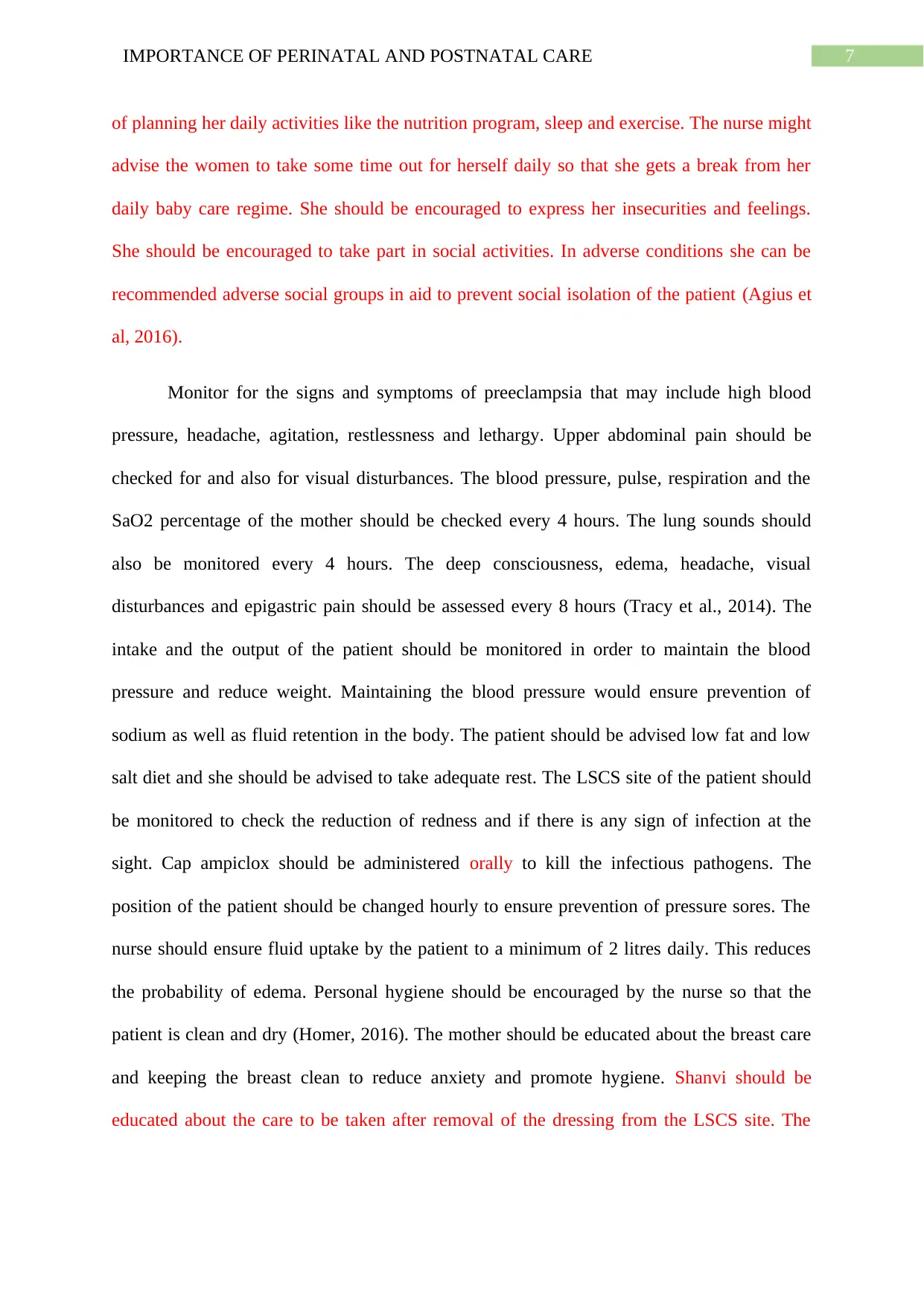
7IMPORTANCE OF PERINATAL AND POSTNATAL CARE
of planning her daily activities like the nutrition program, sleep and exercise. The nurse might
advise the women to take some time out for herself daily so that she gets a break from her
daily baby care regime. She should be encouraged to express her insecurities and feelings.
She should be encouraged to take part in social activities. In adverse conditions she can be
recommended adverse social groups in aid to prevent social isolation of the patient (Agius et
al, 2016).
Monitor for the signs and symptoms of preeclampsia that may include high blood
pressure, headache, agitation, restlessness and lethargy. Upper abdominal pain should be
checked for and also for visual disturbances. The blood pressure, pulse, respiration and the
SaO2 percentage of the mother should be checked every 4 hours. The lung sounds should
also be monitored every 4 hours. The deep consciousness, edema, headache, visual
disturbances and epigastric pain should be assessed every 8 hours (Tracy et al., 2014). The
intake and the output of the patient should be monitored in order to maintain the blood
pressure and reduce weight. Maintaining the blood pressure would ensure prevention of
sodium as well as fluid retention in the body. The patient should be advised low fat and low
salt diet and she should be advised to take adequate rest. The LSCS site of the patient should
be monitored to check the reduction of redness and if there is any sign of infection at the
sight. Cap ampiclox should be administered orally to kill the infectious pathogens. The
position of the patient should be changed hourly to ensure prevention of pressure sores. The
nurse should ensure fluid uptake by the patient to a minimum of 2 litres daily. This reduces
the probability of edema. Personal hygiene should be encouraged by the nurse so that the
patient is clean and dry (Homer, 2016). The mother should be educated about the breast care
and keeping the breast clean to reduce anxiety and promote hygiene. Shanvi should be
educated about the care to be taken after removal of the dressing from the LSCS site. The
of planning her daily activities like the nutrition program, sleep and exercise. The nurse might
advise the women to take some time out for herself daily so that she gets a break from her
daily baby care regime. She should be encouraged to express her insecurities and feelings.
She should be encouraged to take part in social activities. In adverse conditions she can be
recommended adverse social groups in aid to prevent social isolation of the patient (Agius et
al, 2016).
Monitor for the signs and symptoms of preeclampsia that may include high blood
pressure, headache, agitation, restlessness and lethargy. Upper abdominal pain should be
checked for and also for visual disturbances. The blood pressure, pulse, respiration and the
SaO2 percentage of the mother should be checked every 4 hours. The lung sounds should
also be monitored every 4 hours. The deep consciousness, edema, headache, visual
disturbances and epigastric pain should be assessed every 8 hours (Tracy et al., 2014). The
intake and the output of the patient should be monitored in order to maintain the blood
pressure and reduce weight. Maintaining the blood pressure would ensure prevention of
sodium as well as fluid retention in the body. The patient should be advised low fat and low
salt diet and she should be advised to take adequate rest. The LSCS site of the patient should
be monitored to check the reduction of redness and if there is any sign of infection at the
sight. Cap ampiclox should be administered orally to kill the infectious pathogens. The
position of the patient should be changed hourly to ensure prevention of pressure sores. The
nurse should ensure fluid uptake by the patient to a minimum of 2 litres daily. This reduces
the probability of edema. Personal hygiene should be encouraged by the nurse so that the
patient is clean and dry (Homer, 2016). The mother should be educated about the breast care
and keeping the breast clean to reduce anxiety and promote hygiene. Shanvi should be
educated about the care to be taken after removal of the dressing from the LSCS site. The
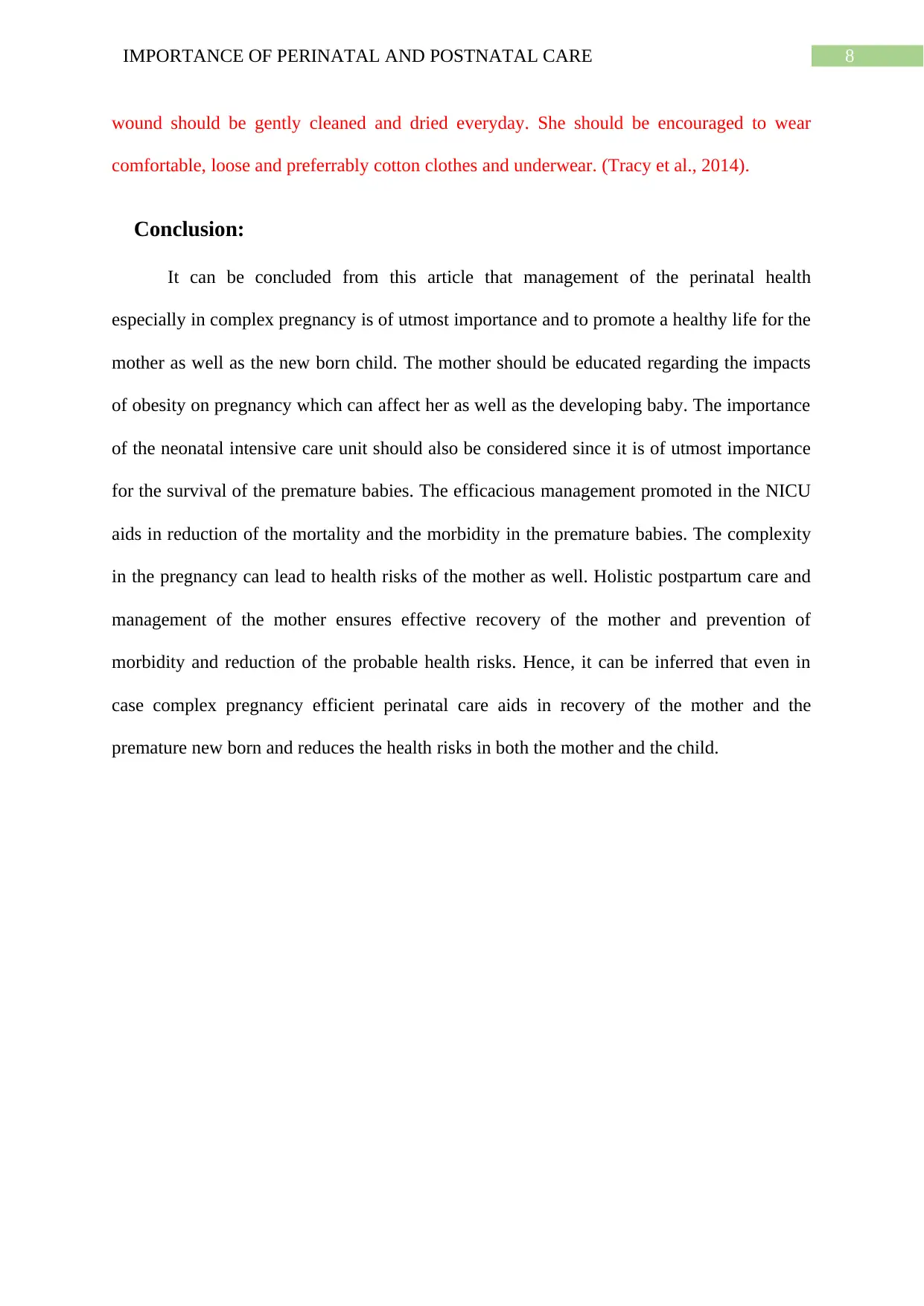
8IMPORTANCE OF PERINATAL AND POSTNATAL CARE
wound should be gently cleaned and dried everyday. She should be encouraged to wear
comfortable, loose and preferrably cotton clothes and underwear. (Tracy et al., 2014).
Conclusion:
It can be concluded from this article that management of the perinatal health
especially in complex pregnancy is of utmost importance and to promote a healthy life for the
mother as well as the new born child. The mother should be educated regarding the impacts
of obesity on pregnancy which can affect her as well as the developing baby. The importance
of the neonatal intensive care unit should also be considered since it is of utmost importance
for the survival of the premature babies. The efficacious management promoted in the NICU
aids in reduction of the mortality and the morbidity in the premature babies. The complexity
in the pregnancy can lead to health risks of the mother as well. Holistic postpartum care and
management of the mother ensures effective recovery of the mother and prevention of
morbidity and reduction of the probable health risks. Hence, it can be inferred that even in
case complex pregnancy efficient perinatal care aids in recovery of the mother and the
premature new born and reduces the health risks in both the mother and the child.
wound should be gently cleaned and dried everyday. She should be encouraged to wear
comfortable, loose and preferrably cotton clothes and underwear. (Tracy et al., 2014).
Conclusion:
It can be concluded from this article that management of the perinatal health
especially in complex pregnancy is of utmost importance and to promote a healthy life for the
mother as well as the new born child. The mother should be educated regarding the impacts
of obesity on pregnancy which can affect her as well as the developing baby. The importance
of the neonatal intensive care unit should also be considered since it is of utmost importance
for the survival of the premature babies. The efficacious management promoted in the NICU
aids in reduction of the mortality and the morbidity in the premature babies. The complexity
in the pregnancy can lead to health risks of the mother as well. Holistic postpartum care and
management of the mother ensures effective recovery of the mother and prevention of
morbidity and reduction of the probable health risks. Hence, it can be inferred that even in
case complex pregnancy efficient perinatal care aids in recovery of the mother and the
premature new born and reduces the health risks in both the mother and the child.
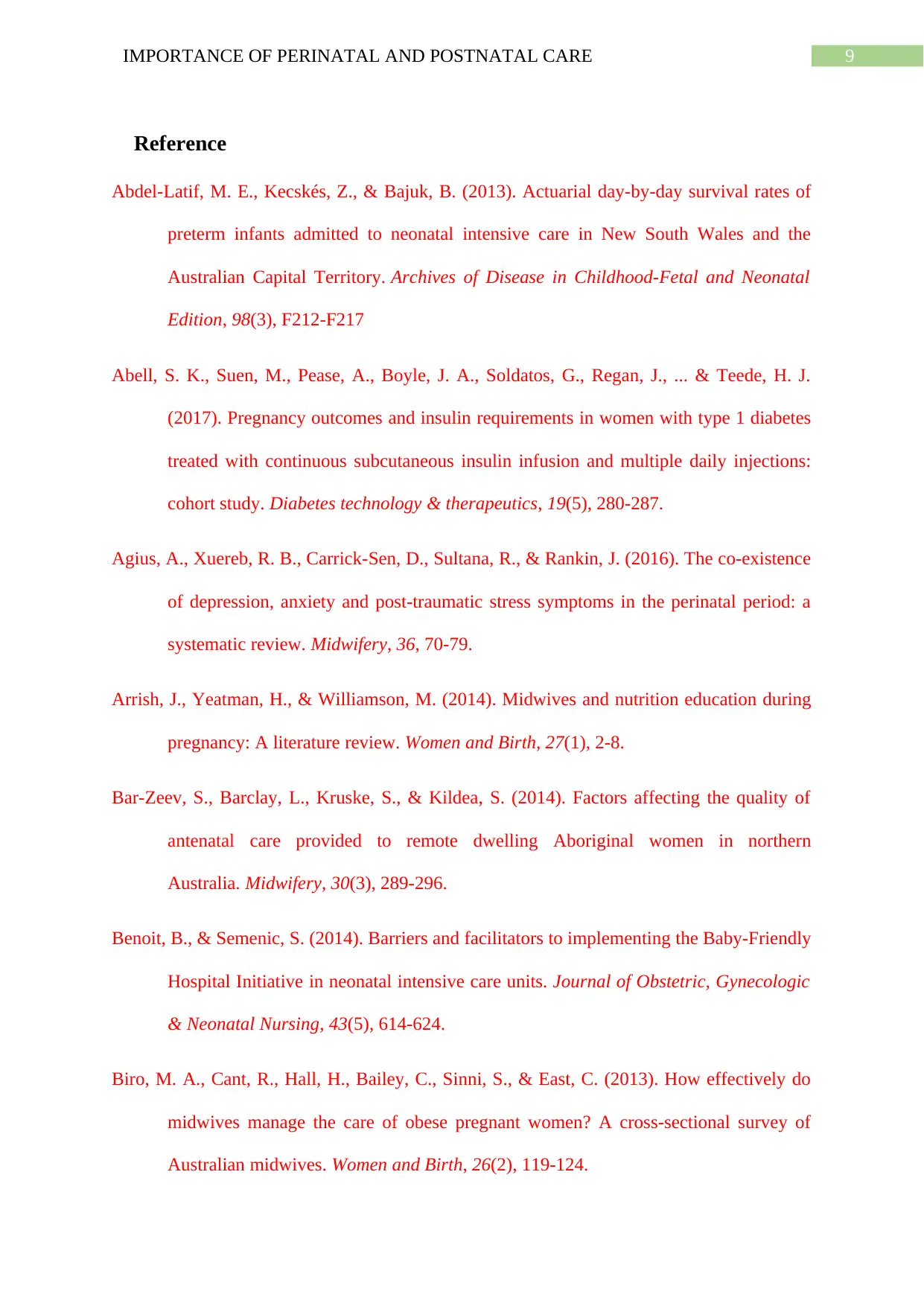
9IMPORTANCE OF PERINATAL AND POSTNATAL CARE
Reference
Abdel-Latif, M. E., Kecskés, Z., & Bajuk, B. (2013). Actuarial day-by-day survival rates of
preterm infants admitted to neonatal intensive care in New South Wales and the
Australian Capital Territory. Archives of Disease in Childhood-Fetal and Neonatal
Edition, 98(3), F212-F217
Abell, S. K., Suen, M., Pease, A., Boyle, J. A., Soldatos, G., Regan, J., ... & Teede, H. J.
(2017). Pregnancy outcomes and insulin requirements in women with type 1 diabetes
treated with continuous subcutaneous insulin infusion and multiple daily injections:
cohort study. Diabetes technology & therapeutics, 19(5), 280-287.
Agius, A., Xuereb, R. B., Carrick-Sen, D., Sultana, R., & Rankin, J. (2016). The co-existence
of depression, anxiety and post-traumatic stress symptoms in the perinatal period: a
systematic review. Midwifery, 36, 70-79.
Arrish, J., Yeatman, H., & Williamson, M. (2014). Midwives and nutrition education during
pregnancy: A literature review. Women and Birth, 27(1), 2-8.
Bar-Zeev, S., Barclay, L., Kruske, S., & Kildea, S. (2014). Factors affecting the quality of
antenatal care provided to remote dwelling Aboriginal women in northern
Australia. Midwifery, 30(3), 289-296.
Benoit, B., & Semenic, S. (2014). Barriers and facilitators to implementing the Baby-Friendly
Hospital Initiative in neonatal intensive care units. Journal of Obstetric, Gynecologic
& Neonatal Nursing, 43(5), 614-624.
Biro, M. A., Cant, R., Hall, H., Bailey, C., Sinni, S., & East, C. (2013). How effectively do
midwives manage the care of obese pregnant women? A cross-sectional survey of
Australian midwives. Women and Birth, 26(2), 119-124.
Reference
Abdel-Latif, M. E., Kecskés, Z., & Bajuk, B. (2013). Actuarial day-by-day survival rates of
preterm infants admitted to neonatal intensive care in New South Wales and the
Australian Capital Territory. Archives of Disease in Childhood-Fetal and Neonatal
Edition, 98(3), F212-F217
Abell, S. K., Suen, M., Pease, A., Boyle, J. A., Soldatos, G., Regan, J., ... & Teede, H. J.
(2017). Pregnancy outcomes and insulin requirements in women with type 1 diabetes
treated with continuous subcutaneous insulin infusion and multiple daily injections:
cohort study. Diabetes technology & therapeutics, 19(5), 280-287.
Agius, A., Xuereb, R. B., Carrick-Sen, D., Sultana, R., & Rankin, J. (2016). The co-existence
of depression, anxiety and post-traumatic stress symptoms in the perinatal period: a
systematic review. Midwifery, 36, 70-79.
Arrish, J., Yeatman, H., & Williamson, M. (2014). Midwives and nutrition education during
pregnancy: A literature review. Women and Birth, 27(1), 2-8.
Bar-Zeev, S., Barclay, L., Kruske, S., & Kildea, S. (2014). Factors affecting the quality of
antenatal care provided to remote dwelling Aboriginal women in northern
Australia. Midwifery, 30(3), 289-296.
Benoit, B., & Semenic, S. (2014). Barriers and facilitators to implementing the Baby-Friendly
Hospital Initiative in neonatal intensive care units. Journal of Obstetric, Gynecologic
& Neonatal Nursing, 43(5), 614-624.
Biro, M. A., Cant, R., Hall, H., Bailey, C., Sinni, S., & East, C. (2013). How effectively do
midwives manage the care of obese pregnant women? A cross-sectional survey of
Australian midwives. Women and Birth, 26(2), 119-124.
Secure Best Marks with AI Grader
Need help grading? Try our AI Grader for instant feedback on your assignments.
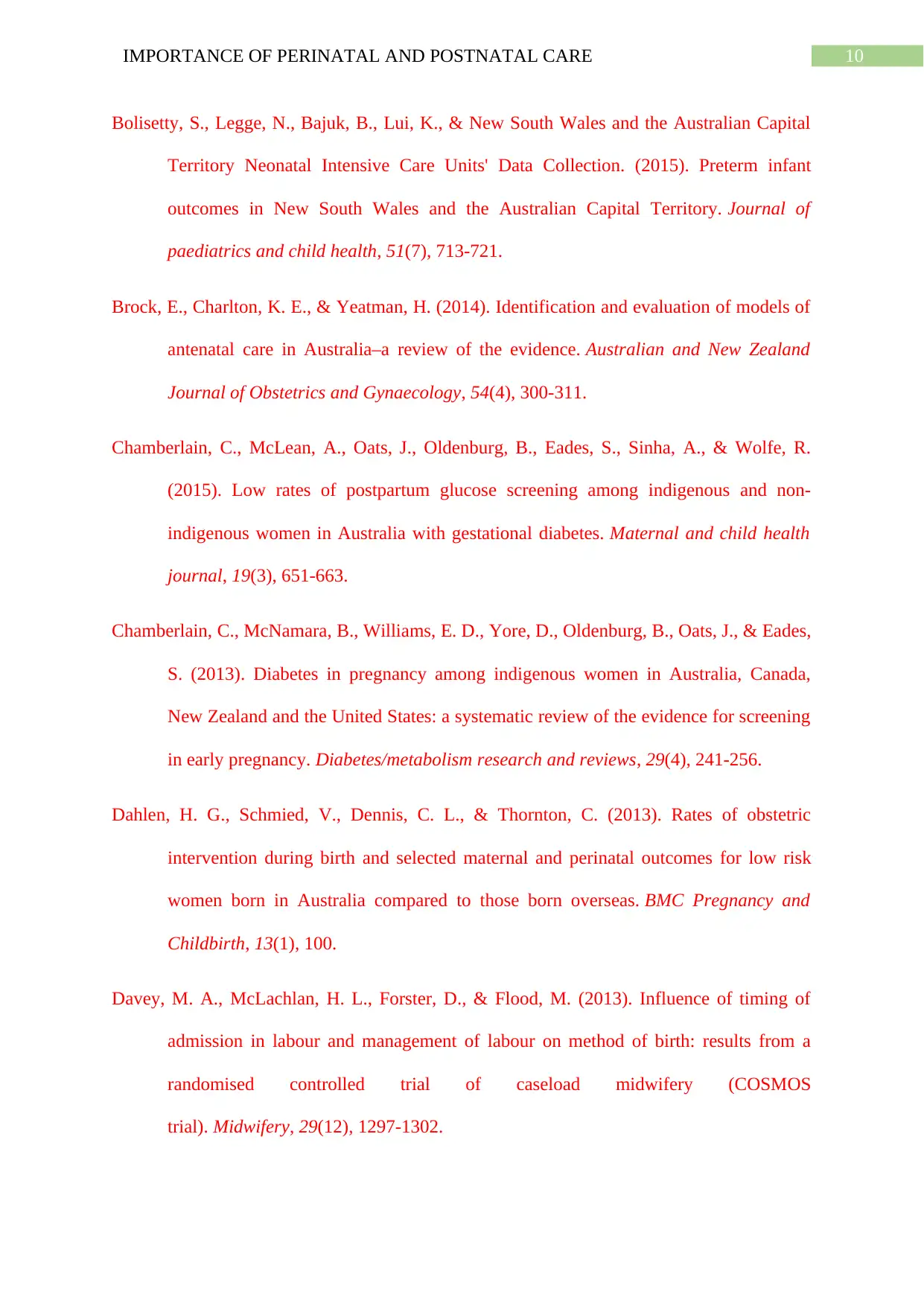
10IMPORTANCE OF PERINATAL AND POSTNATAL CARE
Bolisetty, S., Legge, N., Bajuk, B., Lui, K., & New South Wales and the Australian Capital
Territory Neonatal Intensive Care Units' Data Collection. (2015). Preterm infant
outcomes in New South Wales and the Australian Capital Territory. Journal of
paediatrics and child health, 51(7), 713-721.
Brock, E., Charlton, K. E., & Yeatman, H. (2014). Identification and evaluation of models of
antenatal care in Australia–a review of the evidence. Australian and New Zealand
Journal of Obstetrics and Gynaecology, 54(4), 300-311.
Chamberlain, C., McLean, A., Oats, J., Oldenburg, B., Eades, S., Sinha, A., & Wolfe, R.
(2015). Low rates of postpartum glucose screening among indigenous and non-
indigenous women in Australia with gestational diabetes. Maternal and child health
journal, 19(3), 651-663.
Chamberlain, C., McNamara, B., Williams, E. D., Yore, D., Oldenburg, B., Oats, J., & Eades,
S. (2013). Diabetes in pregnancy among indigenous women in Australia, Canada,
New Zealand and the United States: a systematic review of the evidence for screening
in early pregnancy. Diabetes/metabolism research and reviews, 29(4), 241-256.
Dahlen, H. G., Schmied, V., Dennis, C. L., & Thornton, C. (2013). Rates of obstetric
intervention during birth and selected maternal and perinatal outcomes for low risk
women born in Australia compared to those born overseas. BMC Pregnancy and
Childbirth, 13(1), 100.
Davey, M. A., McLachlan, H. L., Forster, D., & Flood, M. (2013). Influence of timing of
admission in labour and management of labour on method of birth: results from a
randomised controlled trial of caseload midwifery (COSMOS
trial). Midwifery, 29(12), 1297-1302.
Bolisetty, S., Legge, N., Bajuk, B., Lui, K., & New South Wales and the Australian Capital
Territory Neonatal Intensive Care Units' Data Collection. (2015). Preterm infant
outcomes in New South Wales and the Australian Capital Territory. Journal of
paediatrics and child health, 51(7), 713-721.
Brock, E., Charlton, K. E., & Yeatman, H. (2014). Identification and evaluation of models of
antenatal care in Australia–a review of the evidence. Australian and New Zealand
Journal of Obstetrics and Gynaecology, 54(4), 300-311.
Chamberlain, C., McLean, A., Oats, J., Oldenburg, B., Eades, S., Sinha, A., & Wolfe, R.
(2015). Low rates of postpartum glucose screening among indigenous and non-
indigenous women in Australia with gestational diabetes. Maternal and child health
journal, 19(3), 651-663.
Chamberlain, C., McNamara, B., Williams, E. D., Yore, D., Oldenburg, B., Oats, J., & Eades,
S. (2013). Diabetes in pregnancy among indigenous women in Australia, Canada,
New Zealand and the United States: a systematic review of the evidence for screening
in early pregnancy. Diabetes/metabolism research and reviews, 29(4), 241-256.
Dahlen, H. G., Schmied, V., Dennis, C. L., & Thornton, C. (2013). Rates of obstetric
intervention during birth and selected maternal and perinatal outcomes for low risk
women born in Australia compared to those born overseas. BMC Pregnancy and
Childbirth, 13(1), 100.
Davey, M. A., McLachlan, H. L., Forster, D., & Flood, M. (2013). Influence of timing of
admission in labour and management of labour on method of birth: results from a
randomised controlled trial of caseload midwifery (COSMOS
trial). Midwifery, 29(12), 1297-1302.
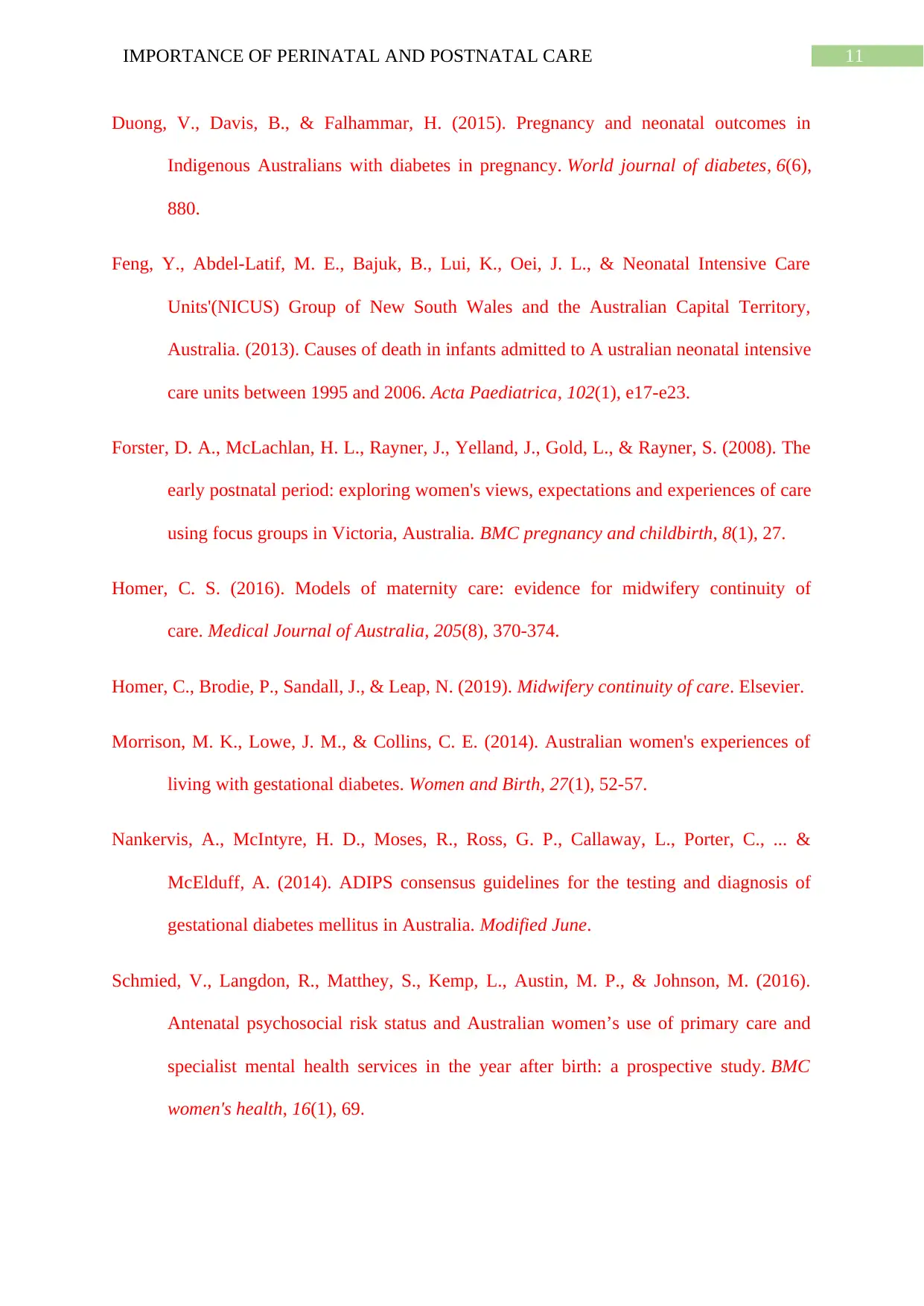
11IMPORTANCE OF PERINATAL AND POSTNATAL CARE
Duong, V., Davis, B., & Falhammar, H. (2015). Pregnancy and neonatal outcomes in
Indigenous Australians with diabetes in pregnancy. World journal of diabetes, 6(6),
880.
Feng, Y., Abdel‐Latif, M. E., Bajuk, B., Lui, K., Oei, J. L., & Neonatal Intensive Care
Units'(NICUS) Group of New South Wales and the Australian Capital Territory,
Australia. (2013). Causes of death in infants admitted to A ustralian neonatal intensive
care units between 1995 and 2006. Acta Paediatrica, 102(1), e17-e23.
Forster, D. A., McLachlan, H. L., Rayner, J., Yelland, J., Gold, L., & Rayner, S. (2008). The
early postnatal period: exploring women's views, expectations and experiences of care
using focus groups in Victoria, Australia. BMC pregnancy and childbirth, 8(1), 27.
Homer, C. S. (2016). Models of maternity care: evidence for midwifery continuity of
care. Medical Journal of Australia, 205(8), 370-374.
Homer, C., Brodie, P., Sandall, J., & Leap, N. (2019). Midwifery continuity of care. Elsevier.
Morrison, M. K., Lowe, J. M., & Collins, C. E. (2014). Australian women's experiences of
living with gestational diabetes. Women and Birth, 27(1), 52-57.
Nankervis, A., McIntyre, H. D., Moses, R., Ross, G. P., Callaway, L., Porter, C., ... &
McElduff, A. (2014). ADIPS consensus guidelines for the testing and diagnosis of
gestational diabetes mellitus in Australia. Modified June.
Schmied, V., Langdon, R., Matthey, S., Kemp, L., Austin, M. P., & Johnson, M. (2016).
Antenatal psychosocial risk status and Australian women’s use of primary care and
specialist mental health services in the year after birth: a prospective study. BMC
women's health, 16(1), 69.
Duong, V., Davis, B., & Falhammar, H. (2015). Pregnancy and neonatal outcomes in
Indigenous Australians with diabetes in pregnancy. World journal of diabetes, 6(6),
880.
Feng, Y., Abdel‐Latif, M. E., Bajuk, B., Lui, K., Oei, J. L., & Neonatal Intensive Care
Units'(NICUS) Group of New South Wales and the Australian Capital Territory,
Australia. (2013). Causes of death in infants admitted to A ustralian neonatal intensive
care units between 1995 and 2006. Acta Paediatrica, 102(1), e17-e23.
Forster, D. A., McLachlan, H. L., Rayner, J., Yelland, J., Gold, L., & Rayner, S. (2008). The
early postnatal period: exploring women's views, expectations and experiences of care
using focus groups in Victoria, Australia. BMC pregnancy and childbirth, 8(1), 27.
Homer, C. S. (2016). Models of maternity care: evidence for midwifery continuity of
care. Medical Journal of Australia, 205(8), 370-374.
Homer, C., Brodie, P., Sandall, J., & Leap, N. (2019). Midwifery continuity of care. Elsevier.
Morrison, M. K., Lowe, J. M., & Collins, C. E. (2014). Australian women's experiences of
living with gestational diabetes. Women and Birth, 27(1), 52-57.
Nankervis, A., McIntyre, H. D., Moses, R., Ross, G. P., Callaway, L., Porter, C., ... &
McElduff, A. (2014). ADIPS consensus guidelines for the testing and diagnosis of
gestational diabetes mellitus in Australia. Modified June.
Schmied, V., Langdon, R., Matthey, S., Kemp, L., Austin, M. P., & Johnson, M. (2016).
Antenatal psychosocial risk status and Australian women’s use of primary care and
specialist mental health services in the year after birth: a prospective study. BMC
women's health, 16(1), 69.
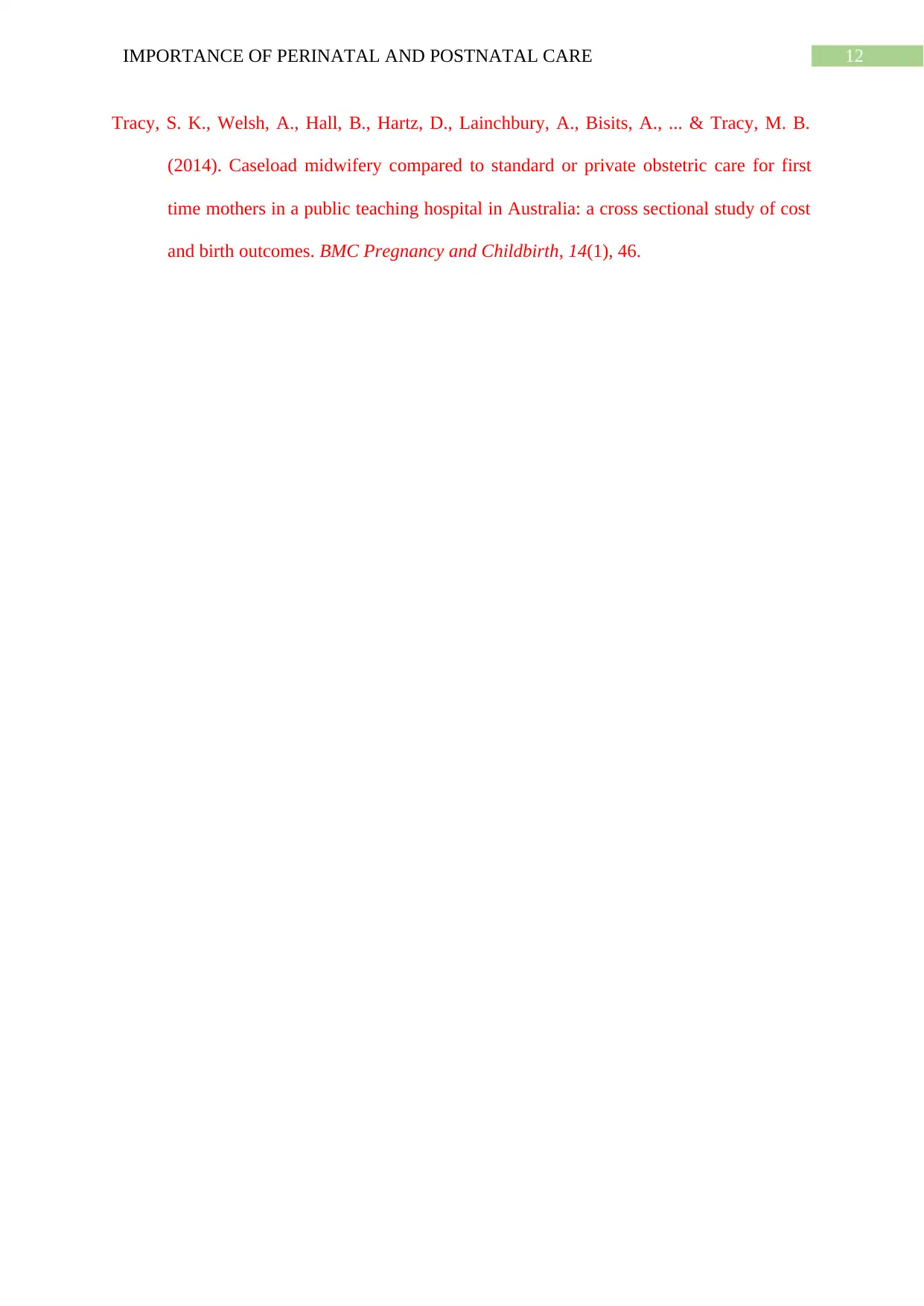
12IMPORTANCE OF PERINATAL AND POSTNATAL CARE
Tracy, S. K., Welsh, A., Hall, B., Hartz, D., Lainchbury, A., Bisits, A., ... & Tracy, M. B.
(2014). Caseload midwifery compared to standard or private obstetric care for first
time mothers in a public teaching hospital in Australia: a cross sectional study of cost
and birth outcomes. BMC Pregnancy and Childbirth, 14(1), 46.
Tracy, S. K., Welsh, A., Hall, B., Hartz, D., Lainchbury, A., Bisits, A., ... & Tracy, M. B.
(2014). Caseload midwifery compared to standard or private obstetric care for first
time mothers in a public teaching hospital in Australia: a cross sectional study of cost
and birth outcomes. BMC Pregnancy and Childbirth, 14(1), 46.
1 out of 13
Related Documents
Your All-in-One AI-Powered Toolkit for Academic Success.
+13062052269
info@desklib.com
Available 24*7 on WhatsApp / Email
![[object Object]](/_next/static/media/star-bottom.7253800d.svg)
Unlock your academic potential
© 2024 | Zucol Services PVT LTD | All rights reserved.




